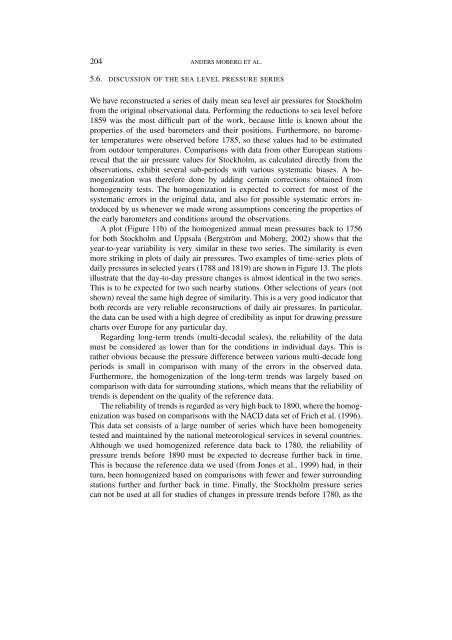DAILY AIR TEMPERATURE AND PRESSURE SERIES ... - BALTEX
DAILY AIR TEMPERATURE AND PRESSURE SERIES ... - BALTEX
DAILY AIR TEMPERATURE AND PRESSURE SERIES ... - BALTEX
Create successful ePaper yourself
Turn your PDF publications into a flip-book with our unique Google optimized e-Paper software.
204 <strong>AND</strong>ERS MOBERG ET AL.<br />
5.6. DISCUSSION OF THE SEA LEVEL <strong>PRESSURE</strong> <strong>SERIES</strong><br />
We have reconstructed a series of daily mean sea level air pressures for Stockholm<br />
from the original observational data. Performing the reductions to sea level before<br />
1859 was the most difficult part of the work, because little is known about the<br />
properties of the used barometers and their positions. Furthermore, no barometer<br />
temperatures were observed before 1785, so these values had to be estimated<br />
from outdoor temperatures. Comparisons with data from other European stations<br />
reveal that the air pressure values for Stockholm, as calculated directly from the<br />
observations, exhibit several sub-periods with various systematic biases. A homogenization<br />
was therefore done by adding certain corrections obtained from<br />
homogeneity tests. The homogenization is expected to correct for most of the<br />
systematic errors in the original data, and also for possible systematic errors introduced<br />
by us whenever we made wrong assumptions concering the properties of<br />
the early barometers and conditions around the observations.<br />
A plot (Figure 11b) of the homogenized annual mean pressures back to 1756<br />
for both Stockholm and Uppsala (Bergström and Moberg, 2002) shows that the<br />
year-to-year variability is very similar in these two series. The similarity is even<br />
more striking in plots of daily air pressures. Two examples of time-series plots of<br />
daily pressures in selected years (1788 and 1819) are shown in Figure 13. The plots<br />
illustrate that the day-to-day pressure changes is almost identical in the two series.<br />
This is to be expected for two such nearby stations. Other selections of years (not<br />
shown) reveal the same high degree of similarity. This is a very good indicator that<br />
both records are very reliable reconstructions of daily air pressures. In particular,<br />
the data can be used with a high degree of credibility as input for drawing pressure<br />
charts over Europe for any particular day.<br />
Regarding long-term trends (multi-decadal scales), the reliability of the data<br />
must be considered as lower than for the conditions in individual days. This is<br />
rather obvious because the pressure difference between various multi-decade long<br />
periods is small in comparison with many of the errors in the observed data.<br />
Furthermore, the homogenization of the long-term trends was largely based on<br />
comparison with data for surrounding stations, which means that the reliability of<br />
trends is dependent on the quality of the reference data.<br />
The reliability of trends is regarded as very high back to 1890, where the homogenization<br />
was based on comparisons with the NACD data set of Frich et al. (1996).<br />
This data set consists of a large number of series which have been homogeneity<br />
tested and maintained by the national meteorological services in several countries.<br />
Although we used homogenized reference data back to 1780, the reliability of<br />
pressure trends before 1890 must be expected to decrease further back in time.<br />
This is because the reference data we used (from Jones et al., 1999) had, in their<br />
turn, been homogenized based on comparisons with fewer and fewer surrounding<br />
stations further and further back in time. Finally, the Stockholm pressure series<br />
can not be used at all for studies of changes in pressure trends before 1780, as the













